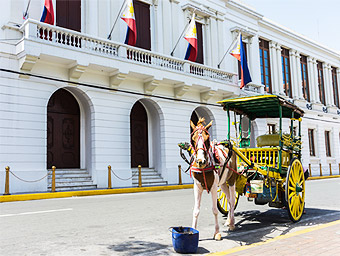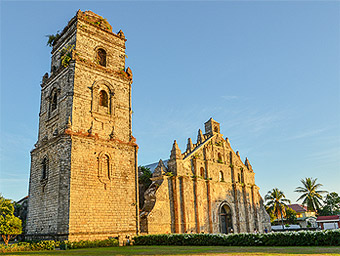




As the American author Pearl Buck said, “In order to understand today, you have to study yesterday”. With such a mixed history this statement certainly rings true for the Philippines.
The Philippines, named after King Philip II of Spain, was a Spanish colony for over 300 years.
The Spanish claimed the islands in 1521 and by 1571 they had built the city of Intramural which later became Manila, the capital of the Philippines. They created a feudal system whereby Spaniards owned vast estates worked by Filipinos.
The Spanish colonization of the Philippines passed uneventfully (for the Spanish at least) until in 1762, when the British captured Manila. They held it for two years before returning it to Spanish control. The Spanish influence can still be seen in the architecture, food and religion (86% of the population is Roman Catholic) of the islands.
 By the late nineteenth century Filipino nationalism was on the rise and the Spanish position in the Philippines was becoming untenable. Sensing increasing tensions in the region the USA, Germany, Britain, France and Japan all sent warships to the Philippines stating that they were doing so to protect their interests. The tensions eventually lead to the Spanish-US war of 1898 leading to the cessation of the Philippines by the US.
By the late nineteenth century Filipino nationalism was on the rise and the Spanish position in the Philippines was becoming untenable. Sensing increasing tensions in the region the USA, Germany, Britain, France and Japan all sent warships to the Philippines stating that they were doing so to protect their interests. The tensions eventually lead to the Spanish-US war of 1898 leading to the cessation of the Philippines by the US.
However, the US victory and assimilation of the islands did nothing to quell the Filipino nationalist movement, leading to further conflict between the native Filipinos and the US from 1899 to 1902 when the Filipino uprising was defeated. American rule continued on a largely peaceful basis with the US promising full independence from US rule in 1945. The lasting legacy of the US assimilation is the fact that 75% of Filipinos now speak English and many believe that English will become the first language of the islands in the next twenty years.
During the Second World War, Japanese troops invaded the islands. By 6 May 1942 all of the Philippines were in Japanese hands, only being liberated three years later by the US.
The Philippines finally gained full independence on 12th July 1946.
Since independence the Philippines has adopted a democratic presidential political system with a senate and congress, loosely based on the US system. Elections for President are held every six years and Presidents are limited to standing for one term only.
 From 1946 to 2016 the office of President has largely been held by four oligarchic families, the Roxas, Marcoses,Arroyos and Aquinos. Earlier Presidencies were shrouded in corruption and their regimes dogged by poverty and inequality. We all, of course, remember Imelda Marcos’ extensive shoe collection.
From 1946 to 2016 the office of President has largely been held by four oligarchic families, the Roxas, Marcoses,Arroyos and Aquinos. Earlier Presidencies were shrouded in corruption and their regimes dogged by poverty and inequality. We all, of course, remember Imelda Marcos’ extensive shoe collection.
There were various military coups attempts in the eighties but since this time, the political situation has become very stable, especially since 2000, and corruption levels have fallen dramatically with increased regulation and privatization of many former state run organs.
Since 2010 the Philippine economy has grown at around 6% a year. The islands have seen huge investment from the US in the service sector, especially call centres, which has seen the Philippines christened the “call centre capital of the world”. This investment has seen rise to a burgeoning middle class with more expendable income. Whilst it would be wrong to deny that there is no poverty in the Philippines, the election of Rodrigo Duterte on an anti-corruption, socially just and economically progressive ticket in 2016 is expected to alleviate much of the same.
Today the population of the Philippines is around 103 million, the twelfth largest in the world, with just under 45% of the population living in urban areas. Unlike many Asian countries, the population continues to grow whilst the median age of the population is a very youthful 24.4 years.
The Philippines is one of the founder members of the UN and a founder member of the Association of South East Asian Nations (ASEAN) which collectively accounts for the seventh largest economy in the world.